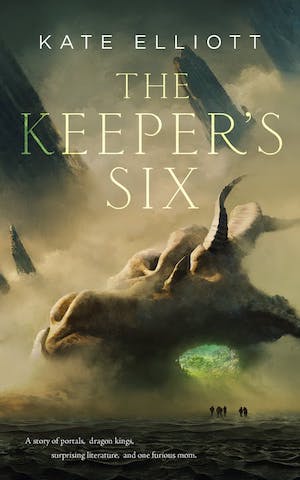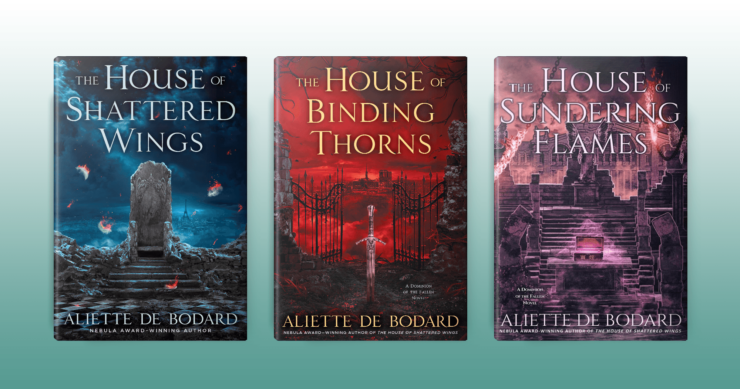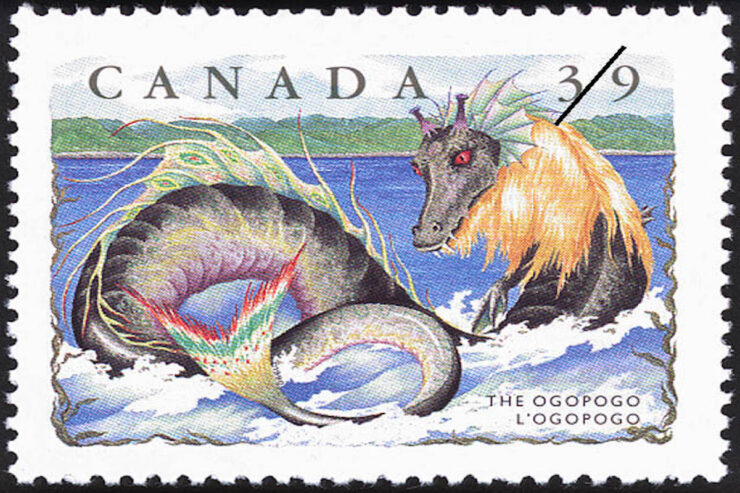Aliette de Bodard’s Dominion of the Fallen is one of my favorite fantasy series of the last couple of decades. In the blasted remnants of Paris after a war that nearly broke the world, mortals and Fallen angels live and die as they can. It’s rich and strange, dark and dystopian, and yet full of hope and profound humanity.
And dragons. There are dragons in the Seine. They’ve been hidden for centuries, but the war has ravaged them just as much as it’s ravaged the land and the river.
These are not Western dragons, at all. They’re Rong from Viet Nam, creatures of water and rain. By nature they’re healers and bringers of serenity.
Even in this Fallen world, they hold on to their original powers and attributes. Their magic is Khi magic, water magic. In some ways it’s an antidote to Fallen magic. In others, it’s a sort of complement to it.
It’s an expatriate Annamite (Annam being one of the regions of Viet Nam) who betrays their secret to the Fallen and the humans of the city. Philippe is a double exile: from his native country and from the courts of Heaven, to which he had ascended as an Immortal, but was cast out. He’s Fallen in his way, though he’s nothing like the rebel angels who have torn the world apart with their wars.
The dragon kingdom is somewhat like the Houses of the Fallen, in that it protects and regiments its inhabitants. It’s ruled over by a Princess after the death of her father, as the Houses are ruled by their heads, who are usually but not always Fallen. They’re all deeply imbued with court intrigue and dangerous plots, and they struggle constantly against the forces of entropy and galloping decay.
These dragons are fully as sentient and quite as complex in their culture as humans and angels. In fact it’s considered good manners to wear human form; they seldom resort to their full-on dragon shape, and when they do, it’s rather not the done thing. As humans however, they usually show signs of their heritage: antlers on their heads, clawed fingers, predators’ teeth, and hints of scales, with a pearl under the chin. The rot that pervades the world may manifest in their faces: open sores, exposed bone.
Theirs is a diverse realm. Many of their court officials are fish or crabs, also wearing human form and demonstrating full sentience. Later in the series we’ll meet orcas and dolphins, too—essentially, any creature of river or sea may live and serve in the dragon kingdom.
One of the Fallen Houses, Hawthorn, sees in the dragon kingdom an opportunity for a unique and unprecedented alliance. The head of House, Asmodeus—yes, that Prince of Hell in our alternative world—proposes a marriage to a prince of dragons. Rivalries and intrigues remove the initial candidate from contention, leaving only one other possibility: the younger son of a third daughter, a shy scholar and none too willing but dutiful spy, whose name is Thuan.
Thuan begins as a make-do. “The bookish one,” he calls himself. He hates court life and is happiest in a library.
At first it seems like a colossal mismatch. Fallen in general are not nice people. At all. Asmodeus is about as not-nice as it gets. He’s a completely unrepentant sadist, a devotee of torture, whose whole life and world are the getting and keeping of power. For entertainment, he stabs people. He resurrects dead Fallen, because he can.
But one thing he will not compromise. He protects the dependents of his House. It’s a form of honor and a sort of integrity.
He’s pretty much everything Thuan loathes. Thuan presents as a soft touch. He does his best to do the right thing, often to his own detriment. His sense of honor is real, and his integrity is just about unshakable.
Buy the Book


The Keeper’s Six
And yet, though at first he finds his new husband horrifying, there’s a spark between them. It grows with time. So does Thuan, who proves himself as a leader, and comes a fully equal co-ruler of House Hawthorn.
Thuan is true to his dragon nature. He rules through cooperation rather than through fear. He would far rather persuade people than stab them—though he’ll do that if there’s no other choice. He’s as much of a misfit in his own realm as he is on dry land, but he finds ways to make it work.
What I love about those books and the shorter works that accompany them is that dragons are not servants or adjuncts to humans. They don’t exist to be ridden or to be slain. They’re people. They have their own culture, their own kingdoms, their own alliances and agendas. A dragon prince can marry a Fallen angel, and they can rule as equals.
Thuan in fact, though he looks like teenager, is centuries old. Technically, he’s the senior partner in the marriage, because Asmodeus Fell from Heaven after Thuan was born. Asmodeus is by far the more experienced politician, but Thuan has his own wisdom, and grows into the confidence that goes with it.
He’s a wonderful character, and his family and his allies and associates are beautifully drawn as well. His Second Aunt, the Princess and later Empress Ngoc Bich, is a powerful ruler and a formidable personality. She has no fear of the Fallen, and is often their superior in both magic and intrigue.
These are dragons with bells on. The interactions of humans and Fallen, colonized and colonizers, are endlessly complex. Dragons add richness and depth and a whole range of colors to the mix. The world is still broken and probably irretrievable, but dragon magic and dragon powers transform it in ways that might, at least somewhat, help to save it.
Judith Tarr is a lifelong horse person. She supports her habit by writing works of fantasy and science fiction as well as historical novels, many of which have been published as ebooks. She’s written a primer for writers who want to write about horses: Writing Horses: The Fine Art of Getting It Right. She lives near Tucson, Arizona with a herd of Lipizzans, a clowder of cats, and a blue-eyed dog.














